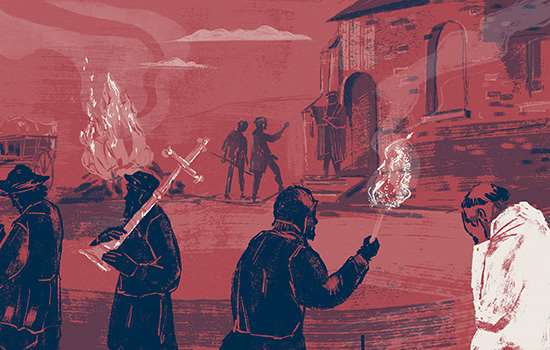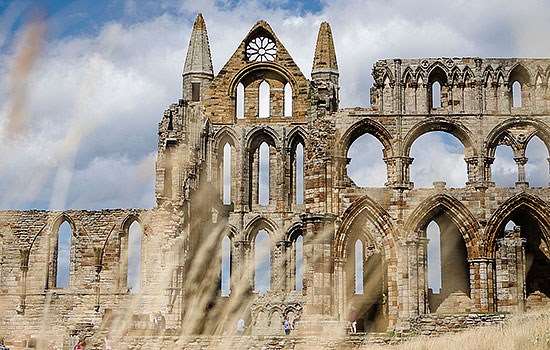Foundation and early history
In 1105, Robert de Haye, a Norman knight, granted the church of St Mary, Boxgrove, together with extensive estates in the vicinity, to the Benedictine abbey of Lessay, Normandy. There were close historical connections between Robert and this monastery, and three monks were dispatched from Lessay to establish a cell at Boxgrove in about 1117. The Domesday Book, the great survey of landownership in England completed in 1086, mentions ‘the clerks of the church’ at Boxgrove, which suggests the presence there of a community of secular canons (a group of priests who did not live according to a monastic rule). These canons would have been supplanted by the monks from Lessay.
The size of the community soon increased to six monks, on the marriage of the founder’s daughter and heiress, Cecily, to Roger St John. By the end of the 12th century this number had grown to 15, thanks to the generosity of their son William. These monks were supported by a considerable endowment of estates, mills and tithes from parish churches.
Boxgrove was now a substantial monastery. In 1187 an agreement was reached with the abbot and monks of Lessay, who undertook to maintain the priory ‘honourably’, not to remove the prior without good cause, and to allow him to recruit monks when vacancies occurred. These were important privileges, though the Boxgrove monks were still required to make their monastic profession – a solemn promise to observe their vows – to the abbot of Lessay, thereby recognising him as their spiritual father, with authority over their monastery.
A thriving community
The church at Boxgrove functioned as both a parish church – where local people worshipped – and a monastic church. Monks and parishioners were strictly segregated, with the parish using the nave at the west end and the monks the eastern parts.
Building works would have commenced as soon as the monks arrived, and the east end of the church, with a small presbytery, was completed in about 1120. The presbytery was the location of the high altar, where the monks celebrated high mass daily. This was substantially rebuilt in about 1190. The new presbytery had eight bays and as well as the high altar it had numerous subsidiary altars, where the monks said commemorative masses for the salvation of their benefactors’ souls.
Boxgrove was dedicated to the Blessed Virgin Mary and St Blaise, a 4th-century bishop from what is now Turkey, who was martyred for his Christian beliefs in 316. In 1235 the Bishop of Chichester granted the priory the right to hold a three-day fair on the days around the feast of St Blaise on 3 February. Altars in the priory church were dedicated to the Virgin and St Blaise, and also to St Catherine, St Michael and St Nicholas. The monks received numerous grants of land to pay for candles to burn at these altars.
The priory continued to benefit from the support of local elites, many of whose gifts were accompanied by requests to be buried at Boxgrove. This was done in the hope that the monks’ prayers would hasten the passage of their souls through the pains of purgatory to eternal bliss in heaven.
The gift of a canon (a senior member of the clergy) of nearby Chichester Cathedral in 1230 enabled the size of the community to increase to 19 monks. The priory maintained its connection with the St John family, with one of the monks serving as chaplain at their manor house at nearby Halnaker.
Numerous benefactors made grants to provide the monks with ‘pittances’. These were special allowances of wine, fine bread or spices which were distributed to the monks on the anniversary of the benefactor’s death: the monks rewarded such generosity with prayers for the benefactor’s soul. Other patrons were rewarded with admission to the priory’s confraternity, or brotherhood, which gave them spiritual benefits as if they were fully professed members of the community. Those granted admission included both men and women.
Boxgrove supported a number of corrodians – individuals who were given daily allowances of bread, ale, fuel and, in some instances, accommodation. Their number could include former servants and retainers, or people who retired to the monastery, providing a cash lump sum for their upkeep until death.
Life in the monastery
Life within the priory was governed by the Rule of St Benedict, a demanding set of instructions that covered most aspects of monastic life. The monks’ waking hours were structured around communal prayer in the priory church, reading in the cloister and manual work.
The records of periodic visitations – formal inspection of the conduct of the prior and monks, by a bishop or his representative – provide valuable insights into life within the priory. In the early 13th century, some of the monks were criticised for being quarrelsome, while a visitation by the Archbishop of Canterbury in 1275 led to the issuing of several injunctions. One reminded the monks about the strict regulations concerning the eating of ‘flesh’ meat (that of four-legged beasts). Another concerned the admission of women to the priory’s church, stating that they were to be restricted to the parish church. If they needed to visit the high altar, they were to transact their business as quickly as possible and were not to speak to the monks.
Relations with Lessay
Relations with Lessay were not always harmonious. At the end of the 13th century, its abbot attempted to interfere with the right of the Boxgrove monks to elect their own prior. The monks mounted a spirited defence, their case reaching the papal chancery in Rome. In 1286, Pope Honorius IV appointed the Prior of Arundel and Dean of Chichester to adjudicate.
War between England and France further complicated relationships between Boxgrove and its Norman mother house. As a so-called ‘alien priory’ – a priory which was dependent on a French monastery – Boxgrove was vulnerable to the seizure of its assets by the English Crown. To avoid this, in 1337 the prior was ordered to pay a £60 fine and an annual fee of £30 to the king. This was beyond the means of the priory. It only escaped financial calamity after showing that it had always had the right to elect one of its own monks as prior, rather than accepting the abbot of Lessay’s appointee. Boxgrove secured independence from Lessay two years later.
There is some evidence that Boxgrove was hard hit by the Black Death. The plague arrived in England in the summer of 1348 and was soon raging across the kingdom. Two priors of Boxgrove died in quick succession in the winter and spring of 1348–9, probably from the plague.
Later history
Relations with the Boxgrove parish priest were not always without conflict. A dispute between the priory and the vicar of the parish in 1409 was only settled after the Bishop of Chichester intervened. The findings of visitations for the most part suggest that Boxgrove was well-run, the monks adhering to their vows. In 1475, when the community had a prior and nine monks – a healthy number for the time – religious life at the priory was said to be better than at any time during the previous 40 years.
A further visitation in 1518 was more critical, but the same injunctions were issued to several other monasteries at the same time, suggesting they were general reminders of the conduct expected of those under religious vows. A visitation in 1524 found little to criticise and another conducted in 1527 reported that all was well. At this time, when Boxgrove had a prior, six monks and five novices, the bishop praised the monks for the quality of their religious life.
Investment in the priory buildings continued: Lambert Barnard, a Chichester-based artist, was commissioned to repaint the vaulted ceiling of the presbytery. Possibly Netherlandish in origin, Barnard is counted among the most important early Renaissance painters working in England at that time. Thomas West, 9th Baron de la Warr, the hereditary patron (descendant of the founder) of the monastery, had an impressive chantry chapel adorned with Renaissance sculpture built for his burial at the priory.
The Dissolution and after
However, Boxgrove was soon swept up in the religious changes of the reign of Henry VIII. In early 1537, Boxgrove was dissolved as one of the ‘lesser’ monasteries. At this time, the community consisted of the prior, eight monks (all priests), a novice, 28 servants and eight children, the latter probably schoolboys. The commissioner responsible for the priory’s suppression wrote to Thomas Cromwell, Henry VIII’s chief minister, saying that thanks to Lord de la Warr’s assistance, more profit was made from the dissolution of Boxgrove than any other monastery in Sussex.
The priory’s buildings, including those around the cloister, were granted to Lord de la Warr. These were rapidly reduced to ruin, though the ‘founders’ lodging’ was allowed to stand. The nave of the church also perished, the parish taking over the monks’ portion in the eastern parts, the location of the de la Warr chantry.
Starting in the 18th century, the history of the priory and its ruins attracted the attention of antiquarians and artists. The latter included Samuel and Nathaniel Buck, who in 1737 published an engraving of the church and surviving portions of the roofless monastic buildings.
The priory today
Today, the monastic ruins are in the care of English Heritage, and the church remains in use by the parish. Of the priory buildings, only the lodging house and parts of the church and chapter house remain, lying to the north and west of the parish church. They are grouped around a small field, which is the site of the priory’s cloister. The remaining monastery buildings lay around the cloister, but do not survive above ground.
Scroll through the image gallery below to find out more about the surviving buildings.
Related content
-

Boxgrove Priory
The guest house and other remains of a Benedictine priory: much of the fine 12th to 14th century monastic church survives as the parish church.
-

WHAT BECAME OF THE MONKS AND NUNS AT THE DISSOLUTION?
Discover what happened to the many thousands of monks and nuns whose lives were changed forever when, on the orders of Henry VIII, every abbey and priory in England was closed.
-

ABBEYS AND PRIORIES
Learn about England’s medieval monasteries and uncover the stories of those who lived, worked and prayed in them.
-

How Silent Were Medieval Monasteries?
To many of us, a visiting a monastic ruin is a peaceful, contemplative experience. But are we right to associate monastic sites with the absence of noise?












